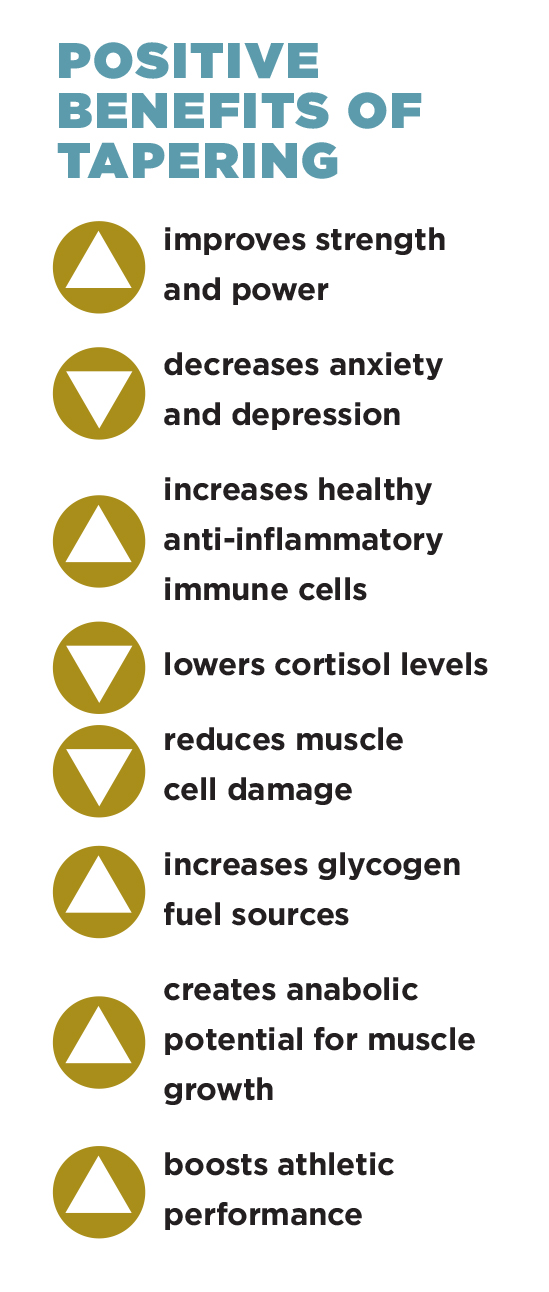Tapering for Resistance Training: Less Is More!
The right rest periods for the best results.

Endurance athletes have used tapering for years; now there’s evidence that exercise enthusiasts and strength and power athletes can benefit from tapering phases in their resistance training (RT) programs. So, is tapering right for your clients? And when it comes to RT, can less work lead to more success? Here’s what the research tells us.
What Is Tapering?
Tapering is a strategically planned recovery period that occurs after a heavy training block and is often used prior to an athletic competition or at the start of a competitive season (Murach & Bagley 2015). There are several ways to execute a successful taper: Reduce training volume (reps x sets), take a complete rest from training, decrease workout intensity (load) or lessen training-day frequency (Murach & Bagley 2015; Turner 2011).
Why Should Your Clients Taper Their Resistance Training Programs?
Like competitive athletes, your recreational exercisers and fitness enthusiasts may benefit from tapering phases, especially if your clients are training at a strenuous level throughout the year. They will not adapt if they become overstressed, and tapering may stimulate advancements in fitness by helping the neuromuscular system recover fully. Furthermore, Murach & Bagley highlight research showing that tapering improves mood and frame of mind, which will help prevent psychological burnout and boost the quality of future training sessions.
Whereas athletes use tapering to prepare for an event or for a competitive season, recreational exercisers can use tapering to transition between phases of a training program. For example, if your client has been training with high volume and low intensity for 6–8 weeks, you can employ a 1- to 2-week taper before beginning a low-volume, high-intensity training block. This will allow the client to be mentally and physically rejuvenated before transitioning to another demanding block of exercise.
Importantly, the benefits extend beyond resistance training. Turner (2011) cites several studies showing that tapering has led to performance gains for weightlifters, rowers, triathletes, cyclists, swimmers and runners.
Where Does Tapering Fit in a Periodized Resistance Training Plan?
Periodization is a systematic and logical training plan that allows fit pros to program for specific physiological outcomes and manage a client’s fatigue and recovery (Turner 2011). (Learn more about how it works in “Periodization for Maximizing Hypertrophy.”)
Strength coaches for some sports employ a taper prior to a competitive season to allow fatigue to dissipate while fitness adaptations solidify. It has been shown that 1–2 weeks of tapering can improve strength, speed and power while reducing feelings of tiredness, depression and anxiety (Turner 2011). Your clients may experience similar benefits by incorporating a taper after a challenging training period. In Rhibi et al. (2016), participants showed improvements in squat jump, countermovement jump and half-squat strength following a 2-week taper phase in which volume dropped by 20%–40%.
Will Short-Term Rest Affect Long-Term Gains?

Rest during tapering does not seem to negatively affect long-term progress.
Some clients may benefit from a complete cessation in training. Uniquely, discontinuous training (DT), which includes 1–3 weeks of complete rest in the middle of an exercise program, may be used as an extreme form of tapering.
For example, Ogasawara et al. (2011) compared the effects of continuous training (CT) versus DT in healthy, untrained male participants. All participants lifted 3 days a week and performed 3 sets of 10 repetitions (75% of 1-RM) on the bench press with 2–3 minutes of recovery between sets. The CT group performed progressive RT for 15 weeks, while the DT group performed 6 weeks of RT, stopped training for 3 weeks and then performed another 6 weeks of RT. Improvements in strength and muscle size in the DT group were similar to those observed in the CT group, meaning the 3 weeks of complete rest did not negatively affect the long-term progress of the DT group.
In another study, Hwang et al. (2017) examined the effect of DT in 20 male participants with at least 1 year of RT experience. During the study, participants lifted for 4 weeks, stopped lifting for 2 weeks (i.e., tapered) and then continued training for 4 weeks after the tapering period. For volume and intensity, the researchers employed 3 sets of 10 repetitions at 75% of 1-RM for all exercises. Results indicated that the 2-week tapering period did not affect muscle size or strength, showing that experienced lifters can maintain their fitness while taking a break from their routines.
Can You Go Too Low?
One tapering strategy used to stimulate recovery in sports athletes reduces RT volume while only slightly reducing intensity. Research suggests that decreasing intensity too much does not benefit performance in some athletes. Specifically, Zaras et al. (2014) examined the effect of low- (30% of 1-RM) and high- (85% of 1-RM) intensity RT during tapering in 13 trained track-and-field athletes.
In this study, participants underwent two separate training blocks of 12 and 15 weeks, followed by 2 weeks of tapering. Muscle thickness did not change during either tapering intervention, meaning the athletes maintained muscle mass even when intensity declined significantly (the 30% of 1-RM taper). However, high-intensity tapering induced greater squat-jump power (+5.1% versus +1%), greater 1-RM leg press strength (+5.9% versus -3.4%), and a higher rate of force development during the 1-RM leg press (+38.1% versus -2.9%). The researchers suggest that if a central goal of including tapering is to increase strength and power overall, it is better to use a higher-intensity taper.
Tapering Within a Program: Two Effective Options
Tapering may resensitize the muscle, causing it to adapt better when it is challenged again.
Program #1:
Taper With Reduced Volume and Sustained Intensity
- Weeks 1–4: 4 sets x 10 repetitions; 75% of 1-RM
- Weeks 5–6 (taper): 2 sets x 10 reps; 75% of 1-RM
- Weeks 7–10: 4 sets x 5 reps; 90% of 1-RM
Program #2:
Taper With Reduced Volume and Intensity
- Weeks 1–4: 4 sets x 10 reps; 75% of 1-RM
- Weeks 5–6 (taper): 2 sets x 15 reps; 60% of 1-RM
- Weeks 7–10: 4 sets x 5 reps; 90% of 1-RM
Conclusions and Practical Application

Effective tapering requires factoring in volume, intensity and duration.
Tapering is an evidenced-based strategy that personal trainers can use to enhance several aspects of fitness and that may also contribute to long-term exercise adherence and enjoyment. Here are some practical tips for designing an effective taper for a client’s individual needs:
Duration. Tapering phases are usually 1–2 weeks and should take place after a period of high-intensity and/or high-volume training. Tapering can also be used to transition between two phases of training within a program.
Intensity. If a principal training goal of the tapering period is to increase/maintain strength and power, we recommend training in a range of 60%–85% of 1-RM. Setting the intensity too low (e.g., 30% of 1-RM) may not lead to the desired outcomes.
Volume. We recommend reducing training volume by 30%–40% during a taper, although researchers have decreased volume by 70% in some studies without compromising neuromuscular performance.
Len Kravitz, PhD
Len Kravitz, PhD is a professor and program coordinator of exercise science at the University of New Mexico where he recently received the Presidential Award of Distinction and the Outstanding Teacher of the Year award. In addition to being a 2016 inductee into the National Fitness Hall of Fame, Dr. Kravitz was awarded the Fitness Educator of the Year by the American Council on Exercise. Just recently, ACSM honored him with writing the 'Paper of the Year' for the ACSM Health and Fitness Journal.
Zachary Mang, PhD
Zachary Mang, PhD, is a postdoctoral research associate for the wellness program at the Los Alamos National Lab where he specializes in strength and conditioning for structural firefighters. His research interests include resistance training for hypertrophy, oxidative adaptations to resistance training, and the use of resistance training as a frontline defense to prevent chronic disease.








